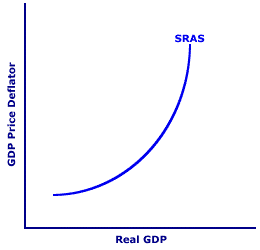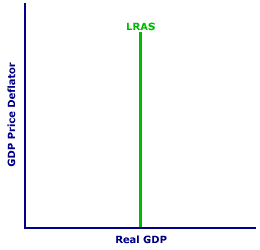
|
|
GROSS DOMESTIC PRODUCT, INCOME: A method of estimating gross domestic product (GDP) based on identifying the income (wages, rent, interest, and profit) received by the owners of the four factors of production (labor, capital, land, and entrepreneurship). This is one of two methods used by the Bureau of Economic Analysis in the National Income and Product Accounts to estimate gross domestic product.
Visit the GLOSS*arama
|
|


|

|
                           AGGREGATE SUPPLY SHIFTS: Changes in the aggregate supply determinants shift both the short-run aggregate supply curve and the long-run aggregate supply curve. The mechanism is comparable to that for market supply determinants and market supply. There are two options--an increase in aggregate supply and a decrease in aggregate supply. An increase in resource quantity or quality or a decrease in resource price shifts one or both of the aggregate supply curves to right. A decrease in resource quantity or quality or an increase in resource price shifts one or both of the aggregate supply curves to left. | Shifting the SRAS Curve | 
| Shifting the LRAS Curve | 
|
To see how this works, consider the short-run aggregate supply curve and long-run aggregate supply curve presented in the exhibit to the right. The short-run aggregate supply curve, abbreviated SRAS, is in the top panel and the long-run aggregate supply curve, abbreviated LRAS, is in the bottom panel.- The short-run aggregate supply curve is positively sloped and captures the specific one-to-one relationship between the price level and real production.
- The long-run aggregate supply curve is vertical at the full-employment level of production, indicating that real production is independent of the price level.
The ceteris paribus factors, that is, the aggregate supply determinants, are assumed to remain constant when these curves are constructed. Similar to other determinants, the aggregate supply determinants shift these two aggregate supply curves. A change in the determinants can either increase or decrease one or both of the aggregate supply curves. - Short-Run Aggregate Supply: Consider first the short-run aggregate supply curve. An increase in short-run aggregate supply is illustrated by a rightward shift in the SRAS curve in the top panel. A decrease in short-run aggregate supply is illustrated by a leftward shift. Click the [Increase in SRAS] or [Decrease in SRAS] buttons for a demonstration.
- Long-Run Aggregate Supply: Now consider the long-run aggregate supply curve. An increase in long-run aggregate supply is illustrated by a rightward shift in the LRAS curve in the bottom panel. A decrease in long-run aggregate supply is illustrated by a leftward shift. Click the [Increase in LRAS] or [Decrease in LRAS] buttons for a demonstration.
What does it mean to have an increase in supply? It means that for every price level, the business sector is willing and able to supply more real production. A decrease in supply is the exact opposite. For every price level, the business sector is willing and able to supply less real production.Shifts of the short-run or long-run aggregate supply curves, brought about by such things as education or technology, an increase in the size of the population or the capital stock, or changes in wages or energy prices, can be the source of disequilibrium in the aggregate market. Such disequilibrium then results in changes in the price level. The key is that aggregate supply determinants CAUSE shifts of the aggregate supply curves which CAUSE disequilibrium which then CAUSES changes in the price level. This suggests an important difference between two related changes--a change in aggregate supply and a change in real production. - A change in aggregate supply is any shift of either of the aggregate supply curves. With this change, the entire curve shifts to a new location. A change in aggregate supply is caused by a change in the aggregate supply determinants. This is comparable to a change in supply in the analysis of the market.
- A change in real production is a movement along a given aggregate supply curve. This change involves the movement from one point on the existing curve to another point on the SAME curve. The curve does not move. A change in real production is caused by a change in the price level, and ONLY a change in the price level! This is comparable to a change in quantity supplied in the analysis of the market.
While a change in real production, as a movement along the curve, applies in principle to both short-run and long-run aggregate supply curves, because real production does not change in the long run, from a practical standpoint, a change in real production primarily applies to the short-run aggregate supply curve.

Recommended Citation:AGGREGATE SUPPLY SHIFTS, AmosWEB Encyclonomic WEB*pedia, http://www.AmosWEB.com, AmosWEB LLC, 2000-2024. [Accessed: April 28, 2024].
Check Out These Related Terms... | | | | | | | | | | | | |
Or For A Little Background... | | | | | | | | | | | |
And For Further Study... | | | | | | | | | | |
Search Again?
Back to the WEB*pedia
|



|

|
GRAY SKITTERY
[What's This?]
Today, you are likely to spend a great deal of time calling an endless list of 800 numbers looking to buy either a how-to book on building remote controlled airplanes or an extra large beach blanket. Be on the lookout for jovial bank tellers.
Your Complete Scope
This isn't me! What am I?
|

|
|
On a typical day, the United States Mint produces over $1 million worth of dimes.
|

|
|
"The roots of education are bitter, but the fruit is sweet." -- Aristotle
|

|
MCA
Monetary Control Act of 1980
|

|
|
Tell us what you think about AmosWEB. Like what you see? Have suggestions for improvements? Let us know. Click the User Feedback link.
User Feedback
|


|


